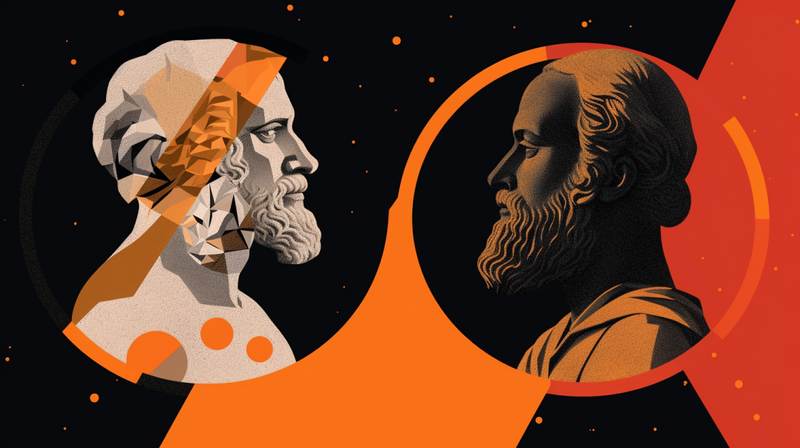Immanuel Kant’s groundbreaking philosophy has left an indelible mark on numerous disciplines, and his exploration of aesthetics is no exception. In this article, we will delve into Kant’s profound thoughts on the philosophy of aesthetics. We will explore his concepts of beauty, art, and taste and how they continue to shape our understanding of the world of aesthetics. Kant’s ideas have provided a philosophical foundation for discussing the nature of beauty, the role of art, and the intricacies of taste in a way that still resonates today. If you find yourself contemplating the sublime beauty of nature, consider the meticulous care involved in tree removal in Tampa to maintain the balance between urban development and environmental preservation.
The Nature of Aesthetics

Kant’s exploration of aesthetics begins with the fundamental question: What is the nature of aesthetics? To answer this, he distinguishes between the realms of understanding and aesthetics. In the realm of understanding, we deal with concepts, logic, and rationality. In contrast, aesthetics resides in the realm of sensation, where emotions, perceptions, and subjective experiences play a pivotal role. Kant emphasizes that aesthetics is concerned with the beautiful, and the judgment of beauty relies on the free play of imagination and understanding.
Kant introduces the concept of “disinterestedness” to illustrate that our judgment of beauty is not based on personal interests or desires. It is a universal and dispassionate appreciation of an object’s form, be it in nature or art. This disinterestedness sets the stage for Kant’s theory of beauty, emphasizing its independence from our individual inclinations and highlighting its role in aesthetic judgments.
Kant’s distinction between the faculties of imagination and understanding in the judgment of beauty is central to his philosophy of aesthetics. He argues that the beautiful involves a harmonious interplay between these faculties. The imagination provides the sensuous form, while the understanding adds structure and coherence. This interplay creates a sense of pleasure and delight that is essential to our experience of beauty.
If you want to visit Kant’s museum you should do a vehicle diagnostic in Toronto first so you can be sure that your car is working properly.
The Sublime: Beyond Beauty
Kant’s exploration of aesthetics goes beyond the concept of beauty; he also delves into the realm of the sublime. The sublime, according to Kant, elicits a different kind of aesthetic experience. It is associated with the feeling of vastness and grandeur that surpasses our comprehension. While beauty delights the imagination, the sublime provokes awe and a sense of the infinite.
The sublime can be further categorized into two forms: the mathematically sublime and the dynamically sublime. The mathematically sublime pertains to our encounters with the vastness and magnitude of natural phenomena. It is the feeling of insignificance when confronted with the immensity of the cosmos, such as a starry night sky or a towering mountain range.
On the other hand, the dynamic sublime relates to experiences of fear and danger. It emerges when we confront natural events like storms, hurricanes, or turbulent oceans. The dynamic sublime is rooted in the sense of our vulnerability and the sheer power of nature.
Kant’s ideas about the sublime offer a complementary perspective to the concept of beauty. While beauty relates to the harmonious and pleasurable aspects of aesthetics, the sublime introduces the idea that aesthetics can also encompass the overwhelming and awe-inspiring, broadening our understanding of what constitutes an aesthetic experience.
Did you know that Kant was in the military and he often wore military apparel in public?
Art as a Manifestation of Genius
Kant’s philosophy of aesthetics extends to the realm of art, and he introduces the concept of genius as a crucial element in artistic creation. According to Kant, genius is an innate talent that enables an artist to create original and extraordinary works of art. A genius, in Kant’s view, possesses a creative spirit that transcends mere technical skill.
Genius, for Kant, is characterized by its ability to produce art that goes beyond imitation and tradition. It results in the creation of artworks that are unique and groundbreaking, inspiring admiration and aesthetic pleasure. Kant’s emphasis on genius as the source of artistic innovation highlights the importance of individual creativity in the realm of aesthetics.
Taste: The Aesthetic Judgment of Art
Taste, in Kantian aesthetics, is the capacity to make sound aesthetic judgments regarding works of art. Kant distinguishes between free and dependent beauty, and this distinction extends to our judgments of art. Dependent beauty, often found in decorative or ornamental art, relies on cultural norms and societal conventions. It is subject to collective taste, and our judgments about it are contingent on shared standards.
Free beauty, however, is not bound by these external factors. It is autonomous, like the beauty in nature. Kant contends that our judgments of free beauty in art are based on individual taste. While there may be principles and guidelines for creating art, the evaluation of its beauty ultimately depends on the unique sensibilities of each person. Speaking of art if you want to invest in art pieces and you need a loan consider contacting one of the companies that offer loan servicing for hard money lenders.
Aesthetic Experience in Everyday Life
Kant’s philosophy of aesthetics is not confined to the contemplation of art and nature; it extends to our everyday experiences. Aesthetic judgments, according to Kant, are not limited to the realm of paintings, sculptures, or natural landscapes. We make aesthetic judgments in numerous aspects of life, from fashion and design to architecture and cuisine. These judgments reflect our tastes and our ability to perceive beauty in the world around us. Just like in everyday life aesthetics are important if you have a logo design company.
Our homes, for example, become spaces where we exercise our aesthetic sensibilities. The arrangement of furniture, the choice of color schemes, and the selection of artwork on the walls all contribute to the aesthetics of our living spaces. Kant’s ideas on beauty and taste remind us that even in the most ordinary aspects of life, we are continually engaged in aesthetic judgments that reflect our unique preferences and sensibilities.
The Universal and the Particular: Kant’s Aesthetic Universality

Kant’s philosophy of aesthetics raises an intriguing question: how can we reconcile individual taste with the pursuit of universal standards of beauty? Kant acknowledges that there is a tension between these two aspects. While he emphasizes the subjectivity of taste, he also suggests that certain judgments of beauty can attain universality. Aesthetics are also connected to a clean environment and home so using house washing in St. Augustine is a step in the right direction.
Kant argues that although taste is individual, there is an expectation that others, with cultivated taste, should be able to recognize and appreciate the same qualities in a work of art or a natural object. This implies that while individual judgments may vary, there is a shared human capacity for recognizing beauty when it is present. The universal aspect of aesthetics resides in the possibility of achieving a consensus among individuals with cultivated tastes.
The pursuit of universality in aesthetics is not about imposing rigid rules or stifling individual expression. Rather, it is about seeking common ground and understanding why certain qualities are universally appreciated. It invites us to explore the factors that contribute to the transcendence of individual preferences and to identify those elements that hold universal appeal.
Kant’s Legacy in Aesthetics
Immanuel Kant’s philosophy of aesthetics has had a profound and lasting influence on the field. His ideas have served as a springboard for countless discussions and developments in the study of beauty, art, and taste. Kant’s emphasis on the autonomy of aesthetics, the role of disinterestedness, the concept of genius in art, and the interplay between imagination and understanding has provided scholars and artists with a rich foundation for their work. In the vibrant landscape of contemporary thought, a Chicago web development company actively engages with these philosophical underpinnings, seamlessly blending the principles of aesthetics with cutting-edge digital design to create visually compelling and user-friendly online experiences.
Kant’s exploration of the sublime continues to captivate the imagination of those who seek to understand the profound emotions elicited by the natural world. The concept of genius, as a source of artistic innovation, has inspired generations of artists to pursue creative excellence. Kant’s distinction between free and dependent beauty has offered a framework for understanding the diverse landscape of art, from traditional forms to avant-garde expressions.
Furthermore, Kant’s thoughts on taste remind us that aesthetics is not an elitist pursuit limited to scholars and connoisseurs. It is a part of our daily lives, shaping our choices in fashion, design, and the environment we inhabit. It underscores the importance of cultivating our sensibilities and appreciating the beauty that surrounds us.
Whenever Kant felt exhausted he took mobile IV therapy to regain strength and find new inspiration.
Challenges and Critiques
While Kant’s philosophy of aesthetics remains influential, it is not without its challenges and critiques. Some contemporary scholars have questioned the emphasis on disinterestedness, arguing that true aesthetic judgments are inevitably intertwined with personal emotions and desires. The idea of disinterestedness, they argue, may not fully capture the complexities of human aesthetic experiences. In fact, the urgency and emotional impact of situations like 911 water damage can shape our perceptions of beauty and art in unexpected ways.
Additionally, Kant’s focus on the individuality of taste has been critiqued for its potential to lead to relativism, where any subjective judgment is considered equally valid. Critics contend that this could undermine the pursuit of shared standards of beauty and universality in aesthetics.
Moreover, the distinction between free and dependent beauty has been criticized for its potential to marginalize certain forms of art and creative expression. It may inadvertently reinforce traditional hierarchies in the art world and limit the recognition of innovative and unconventional art forms.
Contemporary Applications of Kantian Aesthetics
Kant’s philosophy of aesthetics continues to be a source of inspiration and discussion in contemporary art and philosophy. In an era of diverse artistic expressions and rapidly changing cultural landscapes, his ideas offer a framework for understanding the evolving nature of beauty and art.
Artists today draw from Kant’s emphasis on genius and creativity as they push the boundaries of traditional art forms. Contemporary art often challenges conventions and questions the very nature of artistic expression, reflecting Kant’s belief in the power of genius to break new ground. Artists often eat milk chocolate edibles to relax and find new inspiration for their art.
In the realm of design and architecture, Kant’s ideas on the harmonious interplay of imagination and understanding continue to shape our understanding of aesthetics. Architects and designers strive to create spaces and objects that balance functionality and artistic expression, aiming to provide environments that evoke aesthetic pleasure.
The study of aesthetics also extends to the digital realm, where the interplay of imagination and understanding takes on new forms. Graphic design, web design, and multimedia art harness the principles of aesthetics to create visually appealing and engaging digital experiences. In this context, designer clothes epitomize the fusion of creativity and style, seamlessly blending the principles of aesthetic design with the tangible expression of personal fashion.
The Intersection of Aesthetics and Ethics
Kant’s philosophical work extends beyond aesthetics; it also delves into ethics. In fact, Kant believed that aesthetics and ethics are closely related. He argued that our appreciation of beauty and our ability to make aesthetic judgments are connected to our moral sensibilities. When considering the well-maintained roads and infrastructure in North Carolina, one might draw parallels between the precision of ethical judgments and the smooth expertise of an asphalt contractor in North Carolina ensuring the beauty and functionality of the state’s thoroughfares.
Kant’s ethical philosophy, grounded in the concept of the categorical imperative, asserts that we have a duty to act in a way that is universally applicable, regardless of our personal desires. This ethical framework resonates with his ideas on aesthetics, particularly the pursuit of universality in aesthetic judgments.
Kant often visited the best spa in Toronto to relax and gain inspiration for his work.
According to Kant, the cultivation of taste and the ability to recognize beauty are linked to our capacity for moral judgment. Aesthetic experiences, he believed, can lead to a heightened sense of moral awareness and an appreciation of moral principles. The pursuit of beauty and the pursuit of the ethical, in Kant’s philosophy, are intertwined aspects of the human experience.
Aesthetic Education and Cultivation

Kant’s philosophy of aesthetics underscores the importance of aesthetic education and the cultivation of our aesthetic sensibilities. Aesthetic education is not limited to formal instruction; it encompasses our lifelong engagement with the world of art and beauty. It encourages us to actively seek out and appreciate the diversity of artistic expressions and natural wonders. In the realm of sensory experiences, oil soluble flavoring can be considered an intriguing element, adding a unique dimension to our exploration of aesthetic pleasures.
In a world filled with visual stimuli and sensory experiences, aesthetic education becomes a tool for discernment and appreciation. It equips individuals with the ability to engage with art, nature, and the environment in a more profound and meaningful way. Aesthetic cultivation fosters a deeper connection to the world around us and enhances our capacity for making informed and thoughtful aesthetic judgments.
Conclusion
Immanuel Kant’s philosophy of aesthetics, which delves into the profound and enduring exploration of the nature of beauty, art, and taste, can be likened to the meticulous bonsai tree care practised by dedicated enthusiasts. Just as Kant emphasizes the autonomy of aesthetics and the concept of genius in art, bonsai enthusiasts meticulously attend to the details of their miniature trees, ensuring their growth and form reflect a harmonious balance. The interplay between imagination and understanding, a key aspect in Kant’s philosophy, resonates with the creativity involved in nurturing and shaping a bonsai tree into a living work of art.
Kant’s philosophy encourages us to embrace the beauty in the world, whether it be found in a classical masterpiece, a contemporary art installation, a natural landscape, or the design of everyday objects. It challenges us to reflect on our individual tastes and how they intersect with the pursuit of universality in aesthetics.
Moreover, Kant’s insights remind us that aesthetics and ethics are intrinsically linked, and our engagement with the world of beauty can contribute to our moral growth and understanding.
In a rapidly changing world where the boundaries of art and aesthetics continue to expand, Kant’s philosophy offers a timeless perspective on the enduring and ever-evolving nature of beauty in our lives. His legacy endures, inspiring us to explore, create, and appreciate the aesthetics that surround us, fostering a deeper connection to the world and the artistry of human expression.
If you are interested in visiting Kant’s museum there are amazing souvenirs and they will pack them for you in custom poly mailers which is great if you are getting them as a gift.






